 [Image: Ole Bouman, photographed by Cassander Eeftinck Schattenkerk].
[Image: Ole Bouman, photographed by Cassander Eeftinck Schattenkerk].
In May 2005, Ole Bouman and Rem Koolhaas co-founded Volume. Volume was meant as both a magazine and a “global idea platform… dedicated to experimentation and the production of new forms of architectural discourse.” The tenth issue of Volume was published last month.
On April 1, 2007, Ole Bouman will become Director of the Netherlands Architecture Institute in Rotterdam. As he explained in an NAI press release, that role will involve “draw[ing] inspiration from the major spatial challenges of our time.”
In the following interview, Bouman talks to BLDGBLOG about some of these “spatial challenges,” including the role of “agitation” in architecture; who the real audience for architectural journalism might be; the “politics of the spectacular”; unexpected possible side-effects of long-term investment in China; public space and dialogue in post-conflict cities; and the future of the Netherlands Architecture Institute.
• • • BLDGBLOG:
The new issue of Volume
is themed around agitation
. What exactly does that mean in the context of architecture?
Ole Bouman: Agitation is, of course, a very general category. It’s also a cultural term that has strong political connotations. In terms of Volume, as a way of approaching architecture, I think it’s good to cover that theme, to explore agitation in the present state of affairs, and to challenge the accepted formats, the accepted language, the accepted procedures in architecture. It’s a way to expand the architectural imagination in a way.
BLDGBLOG: You’ve said that part of this comes through asking why in architecture.
Bouman: Well, I think it’s very important to acknowledge the necessity of asking why in general. In a culture where people, at a very early stage of their careers, are forced to stick to their subject – or to a specific role – there is, in my view, an extreme urgency to keep asking why. Why, in a way, is a very innocent question and a very childish question – but it is also a very important question. It doesn’t allow you to take things for granted in terms of the role you play in society, or the service you provide to society and things like that. It always brings you back to fundamental questions about your presence, your role, your possibilities – etc. etc. So it’s an extremely important question, and, I would hope, a very obvious question – but, unfortunately, it is not so common anymore.
Posing it so explicitly – pushing forward this notion of why – is itself already a critical act. This is in contrast to presenting what you’re doing, how you are doing it, or – more gossipy – who is doing something. Who and what and how are, of course, very important questions, and there is a big market for those questions: everybody knows that you can make a lot of money presenting what has been done by other people. And there is a growing market now for information about the person behind the built work, the personality behind the building. But for why there is no natural market.
So we are trying to create a momentum behind this spirit, to create a market for why. And if we find sufficient international readers who share this attitude – asking why wherever they go and whatever they do – then maybe this project is sustainable in the long term. But this is an experiment, and we don’t know yet where it will go.
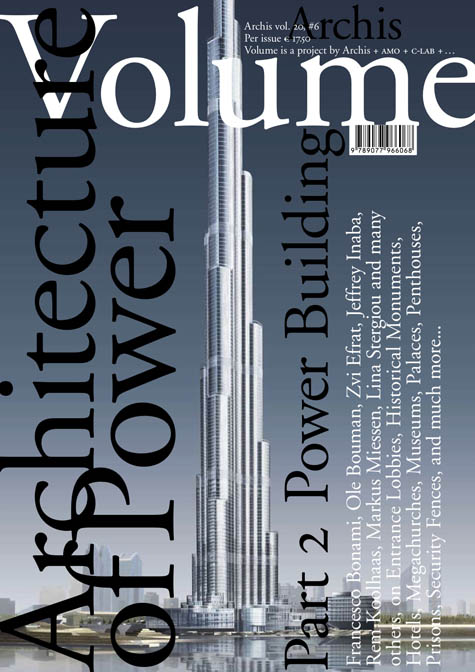 BLDGBLOG: In Volume #6 you refer to the idea that clients are a kind of “necessary evil.” But what’s interesting, in the context of architecture, is that magazines like Dwell and Metropolis are more popular than ever – which seems, at the very least, to indicate that clients read magazines, too. In other words, the people who buy and commission architecture also want to read about architecture. Perhaps, then, the declining popularity of non-mass market architectural criticism simply indicates that critics are not writing for clients anymore – for the people who actually purchase architecture. Instead, they are writing for other architects, and so of course architectural criticism appears to be in decline. Where would Volume fit in, here?
BLDGBLOG: In Volume #6 you refer to the idea that clients are a kind of “necessary evil.” But what’s interesting, in the context of architecture, is that magazines like Dwell and Metropolis are more popular than ever – which seems, at the very least, to indicate that clients read magazines, too. In other words, the people who buy and commission architecture also want to read about architecture. Perhaps, then, the declining popularity of non-mass market architectural criticism simply indicates that critics are not writing for clients anymore – for the people who actually purchase architecture. Instead, they are writing for other architects, and so of course architectural criticism appears to be in decline. Where would Volume fit in, here?
Bouman: It is a good question. Of course, there are at least three different layers of clients. First of all, there are the people with money who want a program to be accommodated by an architectural work – in other words, a client in the traditional sense. But I don’t think that there is a sufficient market for a magazine that would address that specific group.
There is also the client, in terms of the decision-maker. Maybe that person is not about to commission an architect to do something now, but they may ask an architect to do something in the future. And there are decision-makers throughout society – so this is a much larger group. If magazines can address this group of decision-makers specifically, then they already have a bigger reader base.
But, of course, there is also a group of clients that thinks, maybe in a more metaphorical way, about architecture as a way of fulfilling their dreams or serving their interests, in both a material way and in a more idealistic sense. And if our readership is this larger group of people – a very mixed group – then you could say that we already do address clients as the people who ask questions to architects – not just ask for buildings from architects, but who ask architects to engage with these issues. They ask architects to address larger social issues, rather than just supply built stuff. This is a redefinition of architecture, from delivering an object to a definition of architecture that challenges certain issues within a larger cultural strategy.
I think there could be a great dialogue between architects and this group of people. And this spirit and interpretation of the client is perhaps what we are addressing. Of course, the question comes up: is it still necessary to call this group clients and not just the public? But I think it is a nice way to put it: to see those people, this larger group of people engaged in cultural issues, as clients, who ask questions without an immediate budget, without pointing at a specific site, without asking you to accommodate a program. They ask general questions of architecture, and that helps us mobilize architecture beyond one specific purpose.
BLDGBLOG: So we need a new, or different, kind of architect now, in addition to a new way of interacting with clients?
Bouman: Yes – and that brings me to the role of the architect in responding to the client. This can no longer be the reactive way that most architects work with clients. In the first definition I gave of the client, the client is asking a question: Architect X or Architect Y, can you do something for me, because I need you? The output of architecture, in that sense, is very reactive. It can only be based on a program, a budget, a site, an existing location, etc. etc. – but there is always something coming first, before the architectural act.
In the other description I gave of the client, there is more of a shared interest – a common interest – with architects addressing a cultural or political issue from the angle of architecture. So there is a dialogue between different people with a common curiosity, and that can evolve into a completely different output of the architectural discipline. It gives architects a new role, I think, in the long-term, and this may even give architecture its future legitimacy.
If an art form or a scientific discipline, in the end, only boils down to performing a service for other people, then it’s very hard to find cultural legitimacy for that discipline.
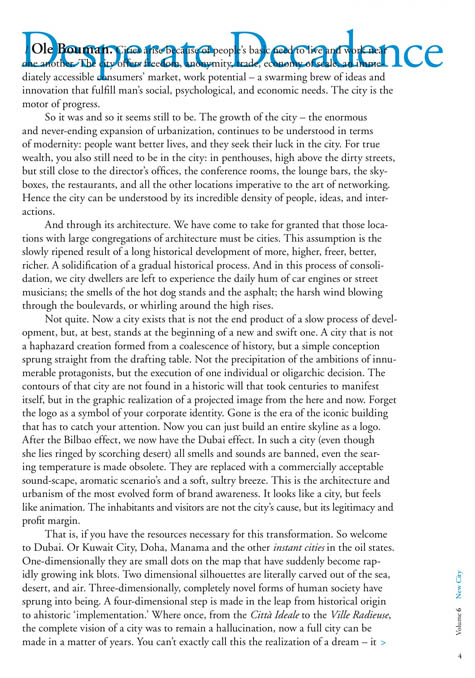 BLDGBLOG: Again in Volume #6, you differentiate between cities and what you call “large congregations of architecture.” I’m curious how this distinction plays out on the level of community, or local identity – what a region full of architecture might mean to its inhabitants.
BLDGBLOG: Again in Volume #6, you differentiate between cities and what you call “large congregations of architecture.” I’m curious how this distinction plays out on the level of community, or local identity – what a region full of architecture might mean to its inhabitants.
Bouman: If you don’t distinguish between those two – if you think that applying urban form is the same as building a city, or even creating urban culture – then you make a very big mistake. First of all, I think it’s necessary for architectural criticism, in that sense, to find the right words for these very complicated processes, to distinguish between two processes or forms that, at first sight, appear the same, but that are, in reality, very different.
When Roemer van Toorn and I wrote the book The Invisible in Architecture in the early 1990s, we were directly reacting to an architecture culture which was taken hostage by the politics of the spectacular. It was an effort to figure out what was behind those fancy or glossy facades which were already highly present in the architectural press – and, in that sense, nothing has changed. There is still an incredible focus – not just among architects, but among clients – on an architecture that is strongest at first sight. The second sight or the third sight is not so important anymore. The invisible in architecture, in that sense, is still an interesting concept to explore: to figure out the intricacies of the architectural profession within a larger political context.
Beyond that, distinguishing between a city and these “large congregations of architecture” may also help architects to clarify their own position, and to see how they might want to work – to help draft a new agenda for the discipline. This brings us back to that notion of agitation. So agitation can also mean: keep going, keep defining alternative agendas that are not well known – or well accepted, or that are just undiscovered – and keep opening windows for other kinds of practice.
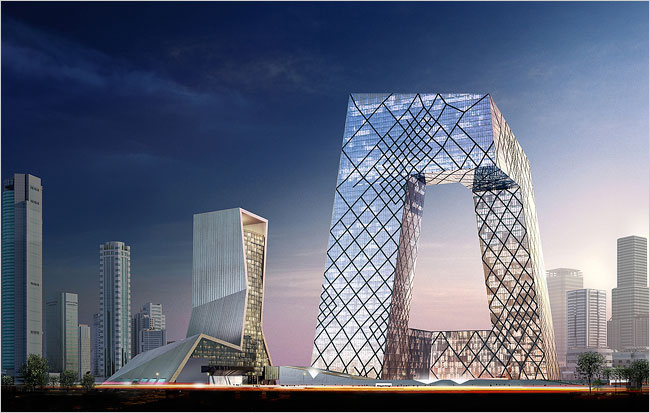 [Image: The CCTV building, Beijing, by Rem Koolhaas/OMA].
[Image: The CCTV building, Beijing, by Rem Koolhaas/OMA].
BLDGBLOG: In Volume #8, you write that China is “an emerging world for which we as yet have no concepts” – but perhaps we do have concepts for it, only we won’t find them in China: we’ll find them within the logic of Western globalization. Do you think, then, that the economic development of China is really just a mutant strain of something that has already happened in the West?
Bouman: Well, there are many angles that could be taken, and I think that’s a good one. It’s strange that China is seen as a new world by many Westerners, a land of opportunity, a place they all want to go. Investors are also looking at China as where they would like to put their money. So, in a way, it’s very similar to concepts we already do have – the concepts of innovation, of career, of success. But also, the concept of a return on your investment, the concept of economic growth – all of those well-known elements of the Western worldview that we all share.
On the other hand, China is still seen as another world. You have to go there. You have to get yourself a portfolio in China. Or you have to start your office, or open a new headquarters there – so there is always the concept of over there, of otherness. I talk to Chinese colleagues, and Chinese businesspeople, and they sometimes openly admit that this persistence of otherness, this persistence of the idea that this is a country that is different from the West, that you can go to, or send your money to, is helping China to take over. To put it dramatically.
So, in terms of capital, for instance, if you just consider the fact that 15 years of boundless investment in China – hundreds of billions of dollars of investment in China, within a very Western paradigm of finding the best returns – is also, in the long-term, undermining the Western position. So, in a Western way of thinking, and from a capitalist point of view, investing in China may actually accomplish the opposite of what investors intended. These kind of paradoxes are hardly understood.
If China is launching a new rocket, or a new satellite, or testing a new space weapon system, suddenly people wake up – but there is this strange anomaly between China as the promised land and China as the latent rival, the opponent, the growing danger. Either people accept that China is becoming part of a larger global system of capital, and so they aren’t afraid to give it its own momentum wherever it goes, or whatever it takes – that is just the price you pay for growth. Or you say: we can no longer accept this – and this might be a moment that is not so far away anymore, a moment of regression or conservatism. Some governments will say that we can no longer go there, maybe, because we would not like to add to the power and culture of China. It’s still very fashionable to host Chinese festivals and to invite Chinese artists and to buy Chinese art – but the moment might not be so far away when we ask: why would we pay for China? If it reinforces or strengthens their power?
I feel sometimes that we are just a little bit away from the moment when this paradox, this anomaly, will erupt into a more existential question. What do we do? Do we keep adding to the strength of China? Or do we go back to this kind of Western chauvinism, or nationalism, and not allow architects, for instance, to work in China or to allow Western investors to invest in China?
I think, in the work of Rem Koolhaas, for instance, this anomaly is almost already on the surface. On the one hand there’s this admiration of the great architect with an incredible track record who goes to build in China, who creates a new monument, a kind of signal of what architecture can do, an incredible achievement. On the other hand, there is this latent, almost open criticism: what does this do for China? Are we giving away our assets to the enemy? I think in the whole discussion around the CCTV Building you see this tension between chauvinism and internationalism, between western interests and the interests of globalization in general, and many other dialectics in the debate being played out through that specific building. That’s why the building is so interesting. As a metaphor, it represents much more than just the fact that it is built for an institution of Chinese power by a powerful western architect; it also reveals something that has to do with the dynamics of our culture – and where architecture can do that, then architecture is gaining in legitimacy.
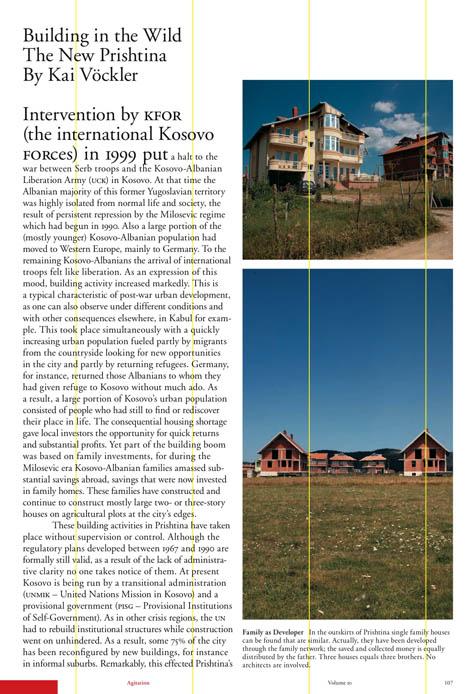 BLDGBLOG: I’m interested in your work – and Volume’s work – with cities like Beirut, Ramallah, and Prishtina. Could you tell me a bit more about the role of architecture and urban design in so-called conflict zones?
BLDGBLOG: I’m interested in your work – and Volume’s work – with cities like Beirut, Ramallah, and Prishtina. Could you tell me a bit more about the role of architecture and urban design in so-called conflict zones?
Bouman: Well, first of all, there are many people there who need help – so it’s a very direct appeal to do something for people who may need you. I don’t have money, and I don’t have power, and I don’t have political influence – but what I can do, together with many other people, is, first, to acknowledge the need for cultural discourse. Very often all the discourse that is left to those people in post-conflict cities is about everyday needs, or maybe some rebuilding of political institutions; but culture is always at the end of the story, at the end of the line. What we can do is provide them with discourse, give them a certain vitality, as we did in Ramallah once, in Bosnia once, in Vilnius once – and even as we did at the feet of the Statue of Liberty once. If a city is in trouble, sometimes it’s good to organize dialogue, regardless of the subject matter – dialogue as a goal in itself.
Of course, the second stage is the content – the subject matter of the dialogue. And for cities like Beirut or Prishtina, a very obvious subject matter is reclaiming the public domain. If there is a situation, as there is in many post-conflict cities, where political parties are extremely weak or even nonexistent, and where private citizens, sometimes criminals, have taken over the public domain because no one feels responsible – there are no owners, so to speak – then it is good to arrive quickly, and to figure out what the public domain can mean in that city.
Beirut, especially now, seems to be a culture that is divided among factions. We’re trying to set up some projects in Beirut, and in the entirety of Lebanon, to specifically address the question of public domain. Or in Prishtina, for instance, there is an incredibly strong tendency to let the public domain be grasped not just by private interests, but by mafia, by criminals. So real estate is no longer an off-spin of the need to build; real estate becomes a modality of corruption, or an exemplification of corrupt wheelings and dealings.
In that sense, it is important to be there, and to acknowledge the work of local architects, designers, civil servants: what they are doing is extremely important, and can be a model for a global discourse. It can be something that we learn from all over the world – because there are so many of those cities, and there is an increasing amount of those cities, that need to learn these lessons.
So we try to go there, to acknowledge the problems, sometimes to help – with just ideas – and to give it exposure; but also to give the local protagonists a certain momentum by connecting them to the international discourse. And if you live in Beirut, or Prishtina, or Ramallah, it might be an incredible thing to feel connected to a more general international discourse.
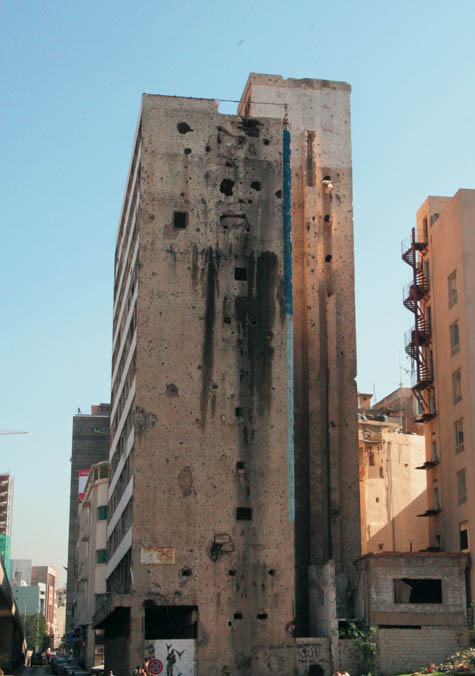 BLDGBLOG: When you go there, who exactly are you networking with? Architects? Civil servants?
BLDGBLOG: When you go there, who exactly are you networking with? Architects? Civil servants?
Bouman: When we decided to go to these places and to organize a dialogue there, we started a practice called RSVP Events. We published an invitation to participate, and we just mentioned the place and the date and the subject matter. People who felt responsible, or who were interested, and who might show up on that date, could react by way of email. After collecting the people who might be interested, we started an email dialogue with this group. And the background of those people was always different – you might find an activist group, or a cultural institution, or a student association, or a school, and they would turn out to be the main provider of content, or the main provider of people, to help. So it’s always different.
In Ramallah, we did a conversation with an organization specifically responsible for heritage in Palestine – in the West Bank – which was a very unexpected turn of events. In Zagreb we worked with a group of students. In Vilnius we were at an art museum. It’s really not fixed – it’s an open system – and it should be that way.
We are trying to set up a new series this year, and, like Beirut and Kosovo, we are planning on going to Ulaanbaator, to Chennai, to Taichung, to Tijuana – different places in borderline situations – and I’m very curious who will eventually help us. We have no institutional connections yet, but we need some; that will help us find a larger audience. We urgently need, always, the email lists, and the local groups that may sustain an event like that.
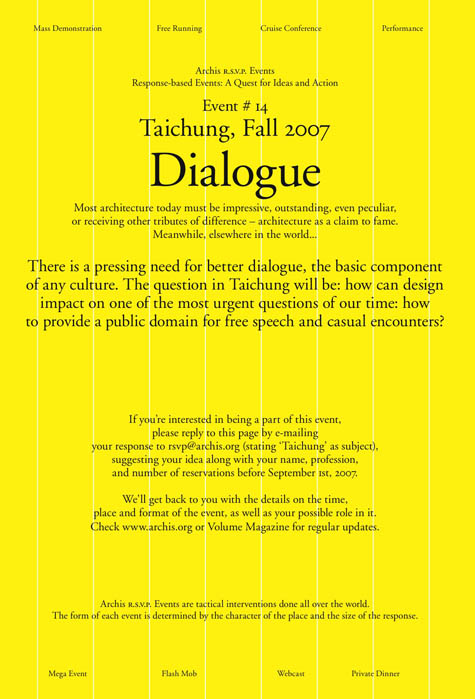
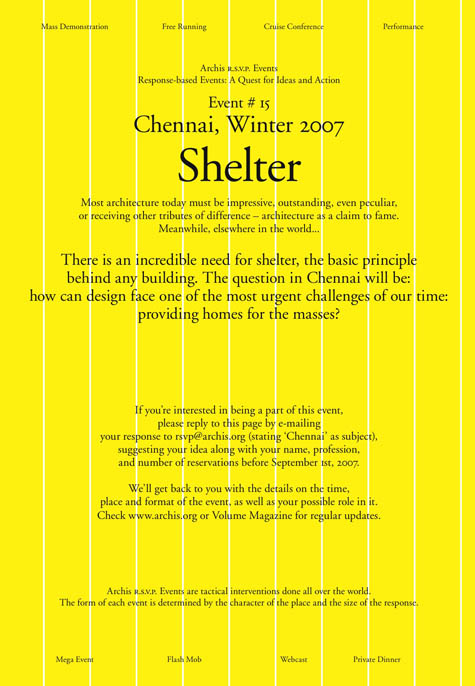 BLDGBLOG: Finally, as far as your new job goes – becoming Director of the Netherlands Architecture Institute on April 1, 2007 – what are your specific plans?
BLDGBLOG: Finally, as far as your new job goes – becoming Director of the Netherlands Architecture Institute on April 1, 2007 – what are your specific plans?
Bouman: [laughs] That’s a huge question – and it’s a question I’m still in the middle of answering. I haven’t found the words for it yet.
Mainly, my role there will be in the spirit of taking architecture as a cultural medium, not just as a profession – taking architecture as a way of thinking, as a metaphor for society, as a medium for culture, and as a very rich historical discipline that can address larger issues. Architecture is more than just serving the spatial needs of society, or providing technical solutions by professionals. Architecture is done by professionals, but that shouldn’t inhibit it to ask the questions of an amateur – very open, curious questions that are larger than just the service, or the facilities, the professional interests of that discipline.
Most of the time, when you find a podium, it is outside the discipline – and, as I said, that’s still successful – but I often wonder why architecture doesn’t seize the opportunity to make itself much more legitimate – more useful, in a way. I think presenting architecture as a potential, a capacity, to pose big questions and to draft agendas that are larger than architecture itself might be a good characterization of things I have in mind.
• • •With special thanks to Benedict Clouette, of Columbia University’s
C-LAB, for setting this interview up and assisting me with images (all unlabeled images come from
Volume); and to Ole Bouman for taking the time to talk.
 [Image: An otherwise unrelated photo of a “Scout” UAV, via Wikipedia].
[Image: An otherwise unrelated photo of a “Scout” UAV, via Wikipedia]. [Image: Ole Bouman, photographed by Cassander Eeftinck Schattenkerk].
[Image: Ole Bouman, photographed by Cassander Eeftinck Schattenkerk]. BLDGBLOG: In
BLDGBLOG: In  BLDGBLOG: Again in
BLDGBLOG: Again in  [Image: The CCTV building, Beijing, by Rem Koolhaas/
[Image: The CCTV building, Beijing, by Rem Koolhaas/ BLDGBLOG: I’m interested in your work – and
BLDGBLOG: I’m interested in your work – and  BLDGBLOG: When you go there, who exactly are you networking with? Architects? Civil servants?
BLDGBLOG: When you go there, who exactly are you networking with? Architects? Civil servants?
 BLDGBLOG: Finally, as far as your new job goes – becoming
BLDGBLOG: Finally, as far as your new job goes – becoming